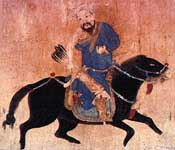Research team to resume its search for burial site of Mongol ruler Genghis Khan
By Josh SchonwaldNews Office
 |
An international research team, co-directed by John Woods, Professor in History and Director of the Center for Middle Eastern Studies, is beginning to prepare for a two-month-long effort to unearth what they hope is the burial site of Genghis Khan, the 13th-century founder of the Mongol Empire.
Woods, American academic director of the joint American-Mongolian Genghis Khan Geo-Historical Expedition and a specialist in the history of Turkey, Iran and Central Asia from the 13th to 18th centuries, said this is the first year the Mongolian government has authorized members of the expedition to excavate. Chief archaeologist Amr Al-Azm of Syria’s University of Damascus will supervise the excavation, which is scheduled to begin in the middle of June.
Woods, who is returning to Mongolia for the third consecutive summer, is confident that this year’s expedition to a site approximately 200 miles northeast of Mongolia’s capital, Ulaanbataar, will yield a finding. “We may not find the big boy,” said Woods, “but we’ll definitely find something.”
The upcoming expedition, the third for a team that Chicago attorney and businessman Maury Kravitz established in 1995, will have 15 more members than last summer’s 25-member team.
Woods, who journeyed to Mongolia to scout the site during spring break, said a road might need to be constructed to provide access to parts of the site and other improvements made to insure the well-being of the researchers next summer.
There are two chief reasons why the team is encouraged to dig for Genghis Khan’s tomb at this location. First, the site contains more than 60 unopened tombs and is encircled by a two-mile wall.
“There are many other large burial sites in Mongolia,” said Woods, “but we don’t know of any others that have an enclosing wall.” The wall varies in height from 9- to 12-feet tall.
Secondly, the primary historical source for the expedition, The Secret History of the Mongols, suggests that the region in which this site is located, near the town of Batirsheet, is a highly symbolic location for the Mongol emperor.
“According to the Secret History, Genghis Khan was born there and enthroned as king there in 1206,” Woods said.
What also are intriguing are the folk legends surrounding the site. The 600-foot hill on which the graveyard is situated, is known by a variety of names: “Almsgivers Castle,” “Chinggis’ Castle” and “Red Rock.” Moreover, Woods said, some local residents refer to a nearby burial ground as the “grave of 100 soldiers.” According to legend, 50 soldiers, detailed there to bury Genghis Khan, were killed by 50 soldiers, who, in turn, also were killed.
Even if Genghis Khan is not buried at this site, Woods said he believes the site could be a medieval burial ground of 16th-century Mongol ruler Dayan Khan. “And, even if that’s what we find, that’s not chopped liver.”
The site was discovered late last summer during the expedition’s second season of surveying areas associated with the life and activities of Genghis Khan, whose exact burial place has never been determined.
The expedition team is planning to spend two months excavating, but Woods cautioned that Mongolia has a narrow and unpredictable digging season. A scourge of biting flies, for instance, prevented the team from exploring one site last year. And if heavy rains begin earlier than anticipated, the expedition would have to be cut short because dirt roads would become muddy and nearly impassable.
If something is found––and some sources suggest treasure is traditionally buried with Mongol kings––the Mongolian government will own all findings. However, the American team will retain permission to travel with, study and display the artifacts.
Woods said he believes the discovery of Genghis Khan’s tomb could be of immense importance for state building in Mongolia, a newly independent country that had been firmly under Soviet control from 1924 until 1992.
This summer’s expedition already is the source of enthusiasm there. “It would be a confidence builder for Mongolia, a source of national pride,” said Woods, who also said the finding would likely spur tourism.
![[Chronicle]](/images/small-header.gif)